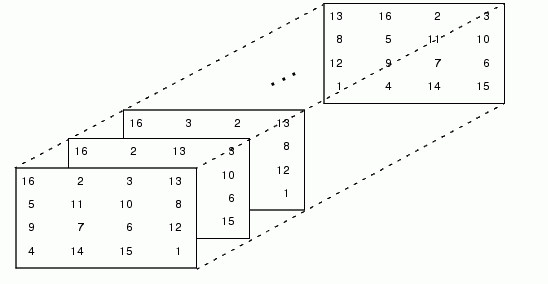

| Getting Started |   |
Multidimensional arrays in MATLAB are arrays with more than two subscripts. They can be created by calling zeros, ones, rand, or randn with more than two arguments. For example,
R = randn(3,4,5);
creates a 3-by-4-by-5 array with a total of 3x4x5 = 60 normally distributed random elements.
A three-dimensional array might represent three-dimensional physical data, say the temperature in a room, sampled on a rectangular grid. Or, it might represent a sequence of matrices, A(k), or samples of a time-dependent matrix, A(t). In these latter cases, the (i, j)th element of the kth matrix, or the tkth matrix, is denoted by A(i,j,k).
MATLAB's and Dürer's versions of the magic square of order 4 differ by an interchange of two columns. Many different magic squares can be generated by interchanging columns. The statement
p = perms(1:4);
generates the 4! = 24 permutations of 1:4. The kth permutation is the row vector, p(k,:). Then
A = magic(4); M = zeros(4,4,24); for k = 1:24 M(:,:,k) = A(:,p(k,:)); end
stores the sequence of 24 magic squares in a three-dimensional array, M. The size of M is
size(M)
ans =
4 4 24

It turns out that the third matrix in the sequence is Dürer's.
M(:,:,3)
ans =
16 3 2 13
5 10 11 8
9 6 7 12
4 15 14 1
sum(M,d)
computes sums by varying the dth subscript. So
sum(M,1)
is a 1-by-4-by-24 array containing 24 copies of the row vector
34 34 34 34
sum(M,2)
is a 4-by-1-by-24 array containing 24 copies of the column vector
34 34 34 34
S = sum(M,3)
adds the 24 matrices in the sequence. The result has size 4-by-4-by-1, so it looks like a 4-by-4 array.
S = 204 204 204 204 204 204 204 204 204 204 204 204 204 204 204 204
 | Other Data Structures | Cell Arrays |  |